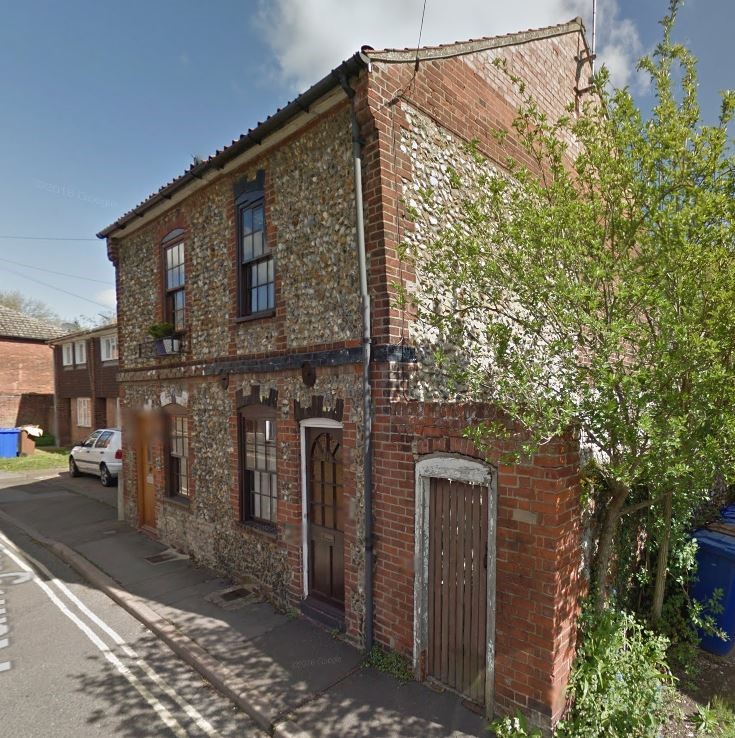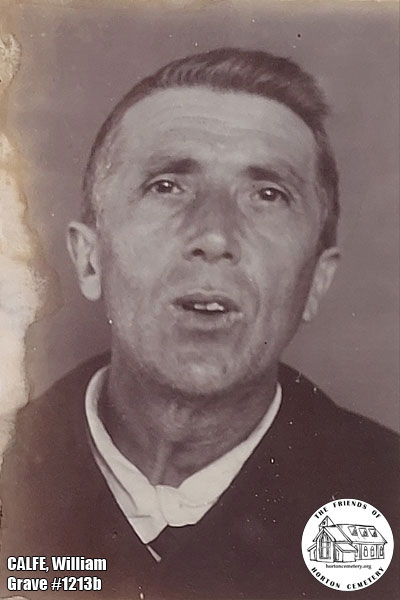b.1851-d.1933
Author’s note
I was very lucky with my research on William. Several Horton team members gave me advice and help, and I was fortunate to find that William’s gt-gt-grandson was a member of Ancestry and thanks to him I was able to gain more information and a photograph of William’s childhood home. Permission to publish this story, has been given by William Calfe’s great great grandson.
Early Life
William CALFE was born at 19 Raingate Street, Bury St. Edmunds, Suffolk, on 9th November 1851 to William & Ellen CALFE. William’s father was a ‘shoemaker’. His parents had married in Suffolk in 1838 and had been living at this address since at least the 1841 census.

William & Ellen’s first son (also called William) had died soon after birth in 1850 and sadly, William’s father was also to die just a few years later in 1859 aged 44.

In the 1861 Census, William’s widowed mother, Ellen, is still living at 19 Raingate Street, Bury St. Edmunds with daughters Catherine aged 13 and Eliza aged 1 month. Life must have been hard for Ellen, she’s working as a ‘boot binder’ and has a lodger, probably to make ends meet following the death of her husband. William is living nearby in Ingham, a small hamlet on the outskirts of Bury St. Edmunds, with Susan FULLER [described as his grandmother, although I cannot confirm this relationship and think it could be an error]. At some point between the 1861 Census and February 1870, William moved to London, possibly to find work.
Marriage and children
On 6th February 1870, William married Sophia Lydia NEWSTEAD at Old St. Pancras, London. The marriage certificate doesn’t name his father but confirms that he is deceased. Both William and Sophia are described as ‘minors’, because at the time of their marriage they were under 21 years old.

The following year (in the 1871 Census) the couple are living at 14 Henry Street, St. Pancras with 11 month old son William and William’s widowed mother, Ellen Calfe. William’s occupation is ‘piano-forte maker’.
Over the next few years, William & Sophia had 8 children (all born St. Pancras), although 4 died within a year of their birth:
- William (1870-1947)
- Sophia (1872-1873)
- Sophia Lydia (1874-1953) bapt. 8.10.1878 at St. James Pancras; abode Little George Street
- Emma (1876-1876)
- Arthur (1879-1940)
- twins: Ellen (twin 1882-1882) and Hannah (twin 1882-1882)
- Albert (14.3.1885-4.10.1917) bapt. 9.9.1895 at St. Pancras; abode 116 Drummond Street.
William’s youngest son, Albert served during WW1 and died of wounds on 4 October 1917 and is buried at Dozinghem Military Cemetery in Belgium.
In the 1881 census, William is living with his wife and children at 30 Augustus Street, St. Pancras. Just four years later we find William entering the asylum system.
William’s journey to the asylum
On 15 May 1885 William entered Hoxton House Aslyum in Hoxton Street, London. Hoxton House was originally a private asylum but it also took in some pauper patients.
William’s stay was brief and he was discharged a month later on 15th September.
Hoxton House has an in interesting history and more information can be found on the following site: https://ezitis.myzen.co.uk/hoxtonhouse.html
Just a year later on 27 March 1886, an Order for the Reception of a Pauper Patient was made against William to be “taken charge of and detained under Care and Treatment” by James Henry Allen JP. A couple of days earlier William had been examined at St. Pancras workhouse by a surgeon who issued the medical certificate stating that he found William to be “incoherent – says there is a conspiracy against him, a ring under the floor”. His wife, Sophia says he “does nothing all day but look out of the window and screams.”
The Reception Order gives William’s home as 30 Stanhope Street, London NW and tells us that his first attack had taken place when he was 33 years old and as a result he had previously been under the care and treatment of Hoxton House Asylum from 15 May 1885 until 15 September 1885. The cause of the attack was unknown. The Order admitted William to the Middx. County Lunatic Asylum at Colney Hatch, Barnet Road, Friern Barnet, north London.
The 1891 census shows William’s wife, Sophia living in Seaton Street, St. Pancras with her surviving children William (aged 20), Sophia (aged 16), Arthur (aged 12) and Albert (aged 6). The eldest two children are both working: William as a French polisher and Sophia as a dressmaker. Although William is named on the census return, there is a note in the census margin confirming that he’s at the Colney Hatch Asylum.
In August 1899, William is transferred from Colney Hatch to Manor Asylum in Surrey. On arrival he was given a medical and we learn that he has brown hair, brown eyes and a fresh complexion. His sight is good, and he has a regular pulse. The most important thing in the notes though is a photo of William! Being able to put a face to the notes makes such a difference and it gives me a stronger connection to him. The notes also state that William “is rambling and confused in his replies to questions. Delusional, hears voices talking to him.” His diagnosis is “chronic mania”.
On 3rd March 1902, William, now aged 50, was transferred again from Manor Asylum to Horton Asylum. Unfortunately, only the case notes from 1912 onwards have survived.
A case note dated 2nd April 1912, describes William as having “secondary dementia. His memory is faulty, he is dull and slow, lacking in ambition and initiative. He has a sore place in his forehead which he picks at continually. Fair health and condition.” Later that year on 27 September, another case note describes William as “A somewhat weak-minded patient. He seems to have no insight into his condition but is perfectly indifferent evidently having no desire to get away. Memory and orientation fair, health good, works on grounds.”
On 4 December 1912, William’s wife, Sophia dies and is buried on 12 December at Camden. I wonder if William was able to attend her funeral; or perhaps he was even unaware of her death.
Case notes dated 27 March 1913, say that William is “a demented patient, condition does not change; does not seem to desire to leave.” In June 1914, William “is irritable and has a bad memory. Very proud of his long time in asylums. General health good. Works in garden.”
The last case notes for William are on 2nd February 1915 – the doctor’s report states that William “gives no answer to me when spoken to but answers attendant and complains of not getting enough food. Health poor.” The following month on 25 March, William is transferred from the Horton Asylum to Cane Hill.
I have been unable to find any information on William’s time at Cane Hill but at some point he returned again to Horton where he died on 2 December 1933 aged 82 from ‘carcinoma of pancreas’ (cancer) which he’d had for at least 6 months. He was buried on 7th December in Plot 1213b.
William lived a long life although sadly spent almost 50 years of it in asylums. It is interesting to see that William’s death was registered by his eldest son, William. Even though William had spent so much time away from his family, it’s good to know that this family cared for, and probably visited him. Sadly, many patients in the asylum system were often neglected or abandoned by their family.





